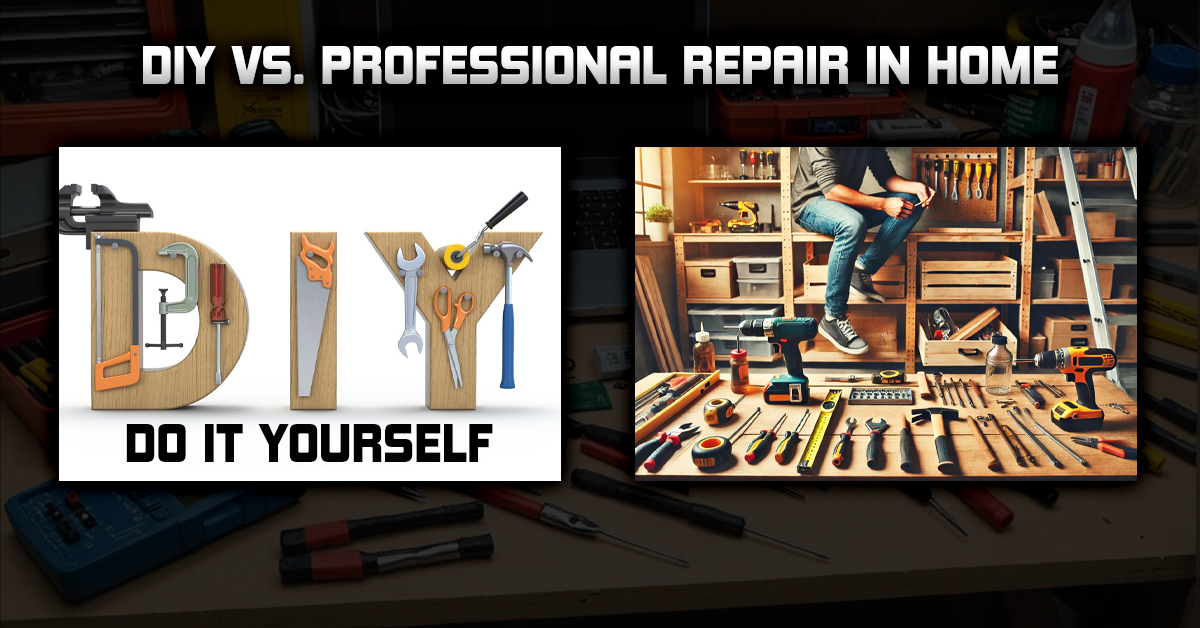Assessing the Scope of Home Repair Tasks
Determining whether to take on a home repair project yourself or hire professionals often depends on factors like safety, complexity, and the potential impact on your home. It’s crucial to evaluate these aspects carefully.

Safety Hazards and Complex Projects
When thinking about home repairs, safety should always be your first concern. Projects that involve electric work or major plumbing can pose significant risks if not handled properly. For instance, installing new electrical wiring without knowledge could lead to serious hazards like fires.
If a project seems too complicated or dangerous, it’s usually best to call a professional. They have the tools and training needed to manage complex repairs safely. By hiring experts, you reduce risks and ensure the job is done correctly.
DIY Renovations vs. Structural Changes
DIY projects can be a great way to learn and save money on simple tasks like painting or basic carpentry. These tasks don’t typically affect your home’s structural integrity and can be a fun way to personalize your space.
However, structural changes like removing a wall or adding extensions require careful assessment. These changes can impact the safety and stability of your home, demanding the expertise of a professional. Missteps in structural work could lead to costly damage or code violations. Always consider your skill level and the complexity of the project before starting.
Understanding Compliance and Regulations
Choosing between DIY and professional repair involves understanding important compliance and regulation factors. Following building codes and obtaining necessary permits is crucial for safety. Adhering to local regulations and professional standards ensures legal work and safety in your projects.
Building Codes and Permit Requirements
When tackling any home repair or construction project, building codes are essential to follow. These codes ensure safety and structural integrity, covering everything from electrical systems to plumbing. Before starting a project, check if a permit is needed.
Permits allow local authorities to regulate and check construction work, ensuring compliance with building codes. For example, installing new electrical wiring typically requires a permit. Ignoring this can lead to legal issues, fines, or even being forced to undo work.
Applying for a permit involves submitting plans for review. This process might seem tedious, but it protects your investment and safety. Skipping permits not only risks penalties but could also affect your insurance policy’s validity.
Local Regulations and Professional Standards
Every area has local regulations that you must adhere to when making repairs. These rules vary greatly between regions, so it’s essential to familiarize yourself with the specific requirements in your area. Local regulations typically include zoning laws, historical preservation rules, and environmental guidelines.
Professional standards also play a significant role. Hiring licensed professionals ensures the work meets industry standards and local regulations. Licensed workers are trained to follow safety and legal guidelines, reducing risks associated with improper installations or repairs.
For larger projects or specialized tasks, consider professional services. They not only provide expertise but also guarantee compliance, protecting you against potential liability issues. Understanding these regulations and standards helps you make informed decisions, ensuring projects are safe and compliant.
Calculating Costs and Potential Savings
Understanding the costs involved in home repairs helps you decide between DIY and hiring a professional. Proper budgeting, time management, and evaluating long-term savings can ensure the best value for your home improvement projects.
Budgeting for Home Improvements
Creating and managing a budget ensures your project stays on track. Key steps include:
- Creating a Budget: Include costs for materials, tools, and additional help. A well-planned budget keeps expenses under control and avoids surprises.
- Tracking Expenses: Record all project-related purchases using spreadsheets or budgeting apps for better financial visibility.
- Allocating Resources: Separate funds for DIY tasks and professional help. Reserve a portion for unexpected issues to avoid financial strain.
DIY Project Efficiency
DIY projects can save money but require careful consideration of time and effort:
- Time vs. Money: DIY reduces labor costs but demands more time. Assess how much time you can realistically commit.
- Skill and Experience: Start with small tasks to build confidence. Leave complex projects to professionals to avoid costly mistakes.
- Materials and Tools: Borrow or rent tools to save money. Research materials to find cost-effective yet quality options for your needs.
Understanding the True Cost of Professional Repairs
Hiring professionals often involves higher upfront costs but provides added benefits:
- Labor and Expertise: Professionals bring advanced tools and skills to ensure the job is done correctly the first time.
- Long-Term Value: Quick and efficient project completion reduces risks of errors, potentially saving money over time.
- Quality Guarantees: Many pros offer warranties, ensuring repairs are covered if issues arise later.
For complex or critical repairs, the reliability and peace of mind professionals offer can outweigh the initial cost.
Evaluating Experience and Skill Levels
When deciding between DIY projects and hiring professionals, it’s crucial to consider your skills and experience. This will help you avoid mistakes and ensure the project is done safely and effectively.
DIY Skill Assessment
Before starting a DIY project, take some time to assess your own skills. Make a list of what you already know and what you might need to learn. Online tutorials can be a great way to learn simple tasks, but they can’t replace hands-on experience.
Think about past projects you’ve completed. Did they turn out well? If complex repairs have been troublesome before, recognize that and be honest about your abilities. Safety should always be your main concern; if you’re unsure, it may be wise to consult a professional.
When to Seek Professional Expertise
Complicated projects often require specialized skills. If a task involves areas like electrical wiring, plumbing, or structural changes, it is more prudent to hire experienced contractors. Professionals not only have the right tools but also understand the risks and regulations involved.
Another factor to consider is time. If a task seems too time-consuming or if you’re learning as you go, seeking professional assistance might be more efficient. This ensures high-quality results and can save you from possible costly errors in the long run.
Determining Project Timelines and Personal Commitment
Deciding between a DIY project or hiring a professional depends largely on your available time and desired level of involvement. DIY projects can be fulfilling but require time and dedication, while professionals offer faster and more efficient solutions.
DIY Time Investment
Taking on a DIY project requires careful consideration of your time commitment. Key points to consider include:
- Time Dedication: Projects like painting a room or building furniture may take weekends or several weeks, depending on complexity.
- Project Phases: Account for planning, purchasing materials, and completing the work.
- Unexpected Challenges: Be prepared for potential difficulties that may extend your timeline.
A clear plan and understanding of the required time can make the process rewarding and help you achieve the desired results efficiently.
Professional Timelines for Renovation Tasks
Hiring a professional can save time and ensure high-quality results. Benefits include:
- Efficiency: Professionals handle tasks quickly due to their expertise and experience.
- Detailed Timeline: After an initial consultation, you’ll receive a clear schedule for the project from start to finish.
- Convenience: Allows you to focus on other commitments while ensuring the work is completed safely and to a high standard.
For complex or time-intensive tasks, hiring an expert can reduce stress and deliver professional-grade results on time.
Frequently Asked Questions
Deciding between DIY and professional home repairs can be challenging. Factors like cost, safety, and the impact on your home’s value play an important role. Here are answers to common questions to help you make the right choice.
1. What factors should be considered when deciding between DIY and professional home repairs?
Consider the following:
- The complexity of the job and the skills required
- Financial costs and potential risks
- Your confidence in your abilities
- Availability of necessary tools
2. How can I determine if a home repair is within my DIY abilities or if it requires a professional?
Match the technical skills needed with your knowledge. If the task involves specialized tools, safety hazards, or unfamiliar techniques, it’s best to consult a professional.
3. What are the potential risks of attempting DIY home repairs without professional experience?
Potential risks include:
- Further damage to your home
- Injuries, especially with electrical or structural tasks
- Lowering your home’s value through poor workmanship
- Violating local building codes
4. How does the long-term cost comparison between DIY and hiring professionals for home repairs play out?
DIY projects can save money upfront but may lead to higher costs if mistakes occur. Hiring professionals often involves a higher initial cost but guarantees quality and safety, which can save money in the long run.
5. Can choosing DIY over professional repair impact the value of my home?
Yes, poor-quality DIY work can decrease home value if buyers notice substandard repairs. Professional repairs often increase value by meeting standards and ensuring long-term durability.
6. What are common home repair tasks that are safe and recommended for DIY versus those that should be left to professionals?
Safe for DIY:
- Painting
- Minor landscaping
- Furniture assembly
Best left to professionals:
- Electrical work
- Major plumbing repairs
- Structural changes



